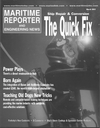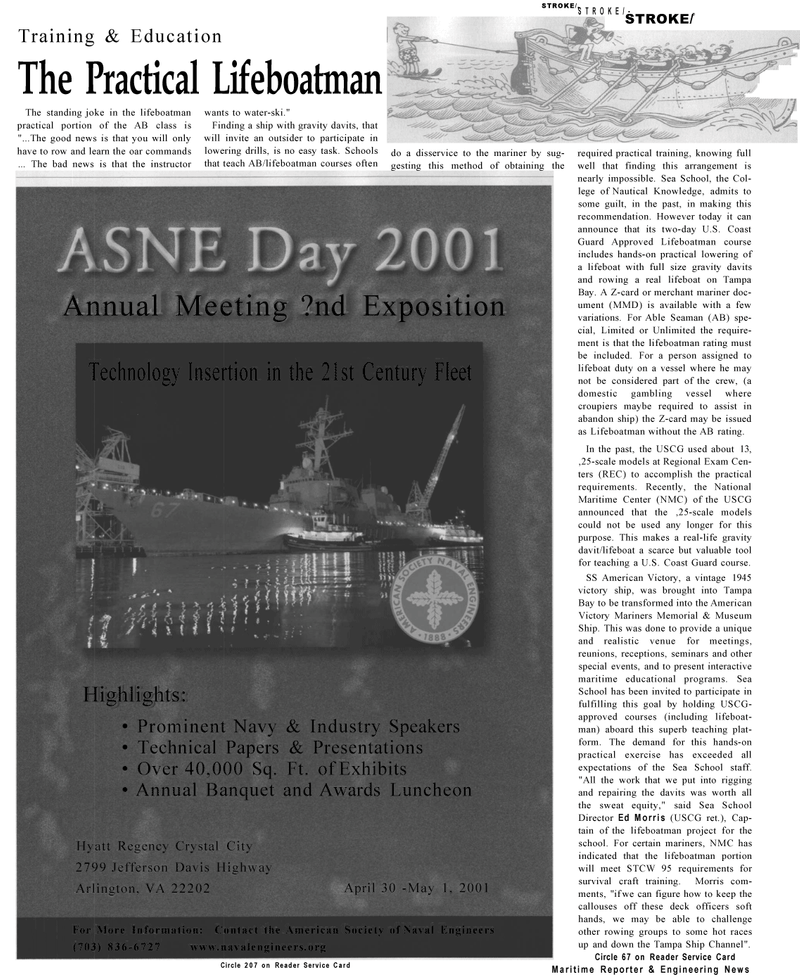
Page 48: of Maritime Reporter Magazine (March 2001)
Read this page in Pdf, Flash or Html5 edition of March 2001 Maritime Reporter Magazine
Training & Education
The Practical Lifeboatman
The standing joke in the lifeboatman practical portion of the AB class is "...The good news is that you will only have to row and learn the oar commands ... The bad news is that the instructor wants to water-ski."
Finding a ship with gravity davits, that will invite an outsider to participate in lowering drills, is no easy task. Schools that teach AB/lifeboatman courses often do a disservice to the mariner by sug- gesting this method of obtaining the
Annual Meeting ?nd Exposition
Technology Insertion in the 21st Century Fleet
Highlights: • Prominent Navy & Industry Speakers • Technical Papers & Presentations • Over 40,000 Sq. Ft. of Exhibits • Annual Banquet and Awards Luncheon
Hyatt Regency Crystal City 2799 Jefferson Davis Highway
Arlington, VA 22202 April 30 -May 1, 2001
For More Information: Contact the American Society of Naval Engineers (703) 836-6727 www.navalengineers.org
Circle 207 on Reader Service Card required practical training, knowing full well that finding this arrangement is nearly impossible. Sea School, the Col- lege of Nautical Knowledge, admits to some guilt, in the past, in making this recommendation. However today it can announce that its two-day U.S. Coast
Guard Approved Lifeboatman course includes hands-on practical lowering of a lifeboat with full size gravity davits and rowing a real lifeboat on Tampa
Bay. A Z-card or merchant mariner doc- ument (MMD) is available with a few variations. For Able Seaman (AB) spe- cial, Limited or Unlimited the require- ment is that the lifeboatman rating must be included. For a person assigned to lifeboat duty on a vessel where he may not be considered part of the crew, (a domestic gambling vessel where croupiers maybe required to assist in abandon ship) the Z-card may be issued as Lifeboatman without the AB rating.
In the past, the USCG used about 13, ,25-scale models at Regional Exam Cen- ters (REC) to accomplish the practical requirements. Recently, the National
Maritime Center (NMC) of the USCG announced that the ,25-scale models could not be used any longer for this purpose. This makes a real-life gravity davit/lifeboat a scarce but valuable tool for teaching a U.S. Coast Guard course.
SS American Victory, a vintage 1945 victory ship, was brought into Tampa
Bay to be transformed into the American
Victory Mariners Memorial & Museum
Ship. This was done to provide a unique and realistic venue for meetings, reunions, receptions, seminars and other special events, and to present interactive maritime educational programs. Sea
School has been invited to participate in fulfilling this goal by holding USCG- approved courses (including lifeboat- man) aboard this superb teaching plat- form. The demand for this hands-on practical exercise has exceeded all expectations of the Sea School staff. "All the work that we put into rigging and repairing the davits was worth all the sweat equity," said Sea School
Director Ed Morris (USCG ret.), Cap- tain of the lifeboatman project for the school. For certain mariners, NMC has indicated that the lifeboatman portion will meet STCW 95 requirements for survival craft training. Morris com- ments, "if we can figure how to keep the callouses off these deck officers soft hands, we may be able to challenge other rowing groups to some hot races up and down the Tampa Ship Channel".
Circle 67 on Reader Service Card
Maritime Reporter & Engineering News
STROKE/, STROKE/- „
STROKE/

 47
47

 49
49
